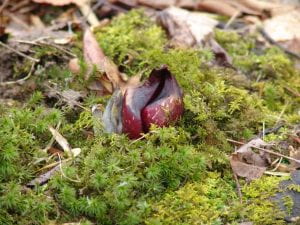One of the things I love about spring are the fleeting perennials that bloom in early to mid-spring and then disappear–the spring ephemerals. An ephemeral is a plant marked by a short life cycle. Desert ephemerals take advantage of short wet periods in arid climates. Mud-flat ephemerals grow in short periods of low water in human disturbed habitats. Spring ephemerals are perennial woodland plants that grow in early spring, quickly bloom and produce seed. As the temperature warms into late spring and summer, the foliage yellows and dies back leaving only underground structures (roots, rhizomes, bulbs) for the remainder of the year. Then, next spring the cycle repeats itself. These small herbaceous plants take advantage of sunlight reaching the forest floor that will be blocked as soon as forest trees leaf out fully.
One of the first spring ephemerals to bloom is the skunk cabbage (Symplorcarpus foetidus). Skunk cabbage, you say? I didn’t know skunk cabbage had a flower. These flowers are subtle, blend in with the forest duff, and bloom extremely early (February-March) before most people have thought about entering the woods. If we get a warm late winter day, in can be fun to go looking for the skunk cabbage flowers. Find a moist woodland and look carefully. Now, though, is the time skunk cabbage really shines. The huge, almost chartreuse leaves brighten up the forest and make big sweeps in wet areas. They do go through an awkward period as the foliage dies back, but don’t we all at one time or another.
My favorite spring ephemeral story is one I tell on myself. When I moved into my current property and was the proud owner of a bit of piedmont woods, I wanted to plant native plants and help the forest along to be all that it could be. At the University of Delaware Botanic Garden Plant Sale (April 27 this year at the College of Agriculture and Natural Resources in Newark) I bought a flat of trout lilies to plant in the woods. Trout lily (Erythronium americanum) has a small yellow flower with recurved petals. It gets its name for the small mottled leaves that look like the skin of a brook trout. That afternoon, I proudly trudged down into the woods with my flat of a dozen trout lilies to find hundreds (maybe thousands) of them blooming in the stream valley. It seemed ridiculous to add my freshly purchased twelve to nature’s bounty already thriving. I could have planted them closer to the house in a landscape bed, but I didn’t have the moist conditions they need to thrive in a bed, so I took the plants back and let someone else find a good home for them.
Another favorite spring ephemeral is Virginia bluebells (Mertensia virginica). Virginia bluebells also grow in colonies in stream valleys, but you can plant them in moist garden beds. Soft magenta buds open to tubular sky-blue flowers. They last a few weeks but are so cheery while in bloom they are worth the short appearance.
Bloodroot (Sanguinaria candensis) is a great spring ephemeral because the foliage is interesting after the flower is gone. Flowers have 8-12 delicate white petals surrounding bright yellow stamens. Each flower is borne on an individual stalk before the leaves unfold. Once the flowers die back, you can easily spot the distinctive large basal leaf with five to seven lobes. Bloodroot seeds are spread by ants. The seeds have a fleshy organ, called an elaiosome, that attracts ants. The ants take the seeds back to their nest, where they eat the elaiosome and the seeds fall into the nest debris, ready to germinate next year.
One of the biggest threats to spring ephemerals in the mid-Atlantic woodland is an invasive plant called lesser celandine (Ranunculus ficaria). It is also a spring ephemeral but comes from Eurasia. It emerges earlier than our native spring ephemerals and is so vigorous it forms a dense carpet in the woods, shielding our native plants from the sunlight and competing for resources. Some of the invasive plants in our woodlands confuse native insects. Garlic mustard (Alliaria petiolata) looks a lot like our native cut-leaf toothwort (Cardamine concatenata). So much so that West Virginia white butterflies, whose only food source is native toothwort, mistakenly lay their eggs on garlic mustard. When young larvae emerge, they feed on garlic mustard leaves and most die.
One of the best places to see spring ephemerals is Mt. Cuba Center in Hockessin, DE. Their Annual Wildflower Celebration is Sunday, April 28. If you go you can enjoy a magnificent display of spring ephemerals at their annual celebration of the season. Stroll through the native plant gardens at the peak of their glory; enjoy live music, gardening demonstrations, family programming, and more. A variety of food selections are available and, in response to requests from Mt. Cuba Center’s visitors, a selection of native plants will be available for purchase, while supplies last. If you miss the Wildflower Celebration, you can still visit Wednesday to Sunday from 10 AM to 4 PM (April through November), but hurry before the ephemerals disappear.
If you want to purchase native plants for your woods or anywhere is in your garden, try the UDBG Plant Sale at Ag Day on Saturday, April 27, Delaware Nature Societies’ Native Plant Sale at Coverdale Farm Preserve on May 3 and 4 and Brandywine Conservancy on May 11 and 12. Of course many local garden centers also carry native plants.




